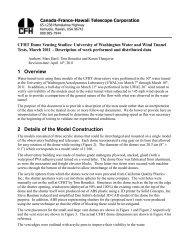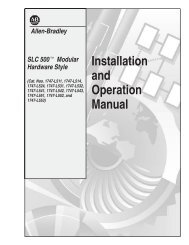Documentation [PDF] - Canada France Hawaii Telescope ...
Documentation [PDF] - Canada France Hawaii Telescope ...
Documentation [PDF] - Canada France Hawaii Telescope ...
Create successful ePaper yourself
Turn your PDF publications into a flip-book with our unique Google optimized e-Paper software.
Figure 23: Distribution of exposure times over the Wide fields. The inset is a close-up view of the long exposure<br />
tails.<br />
4.2 Seeing and image quality<br />
All seeing values reported in this document and in tables are computed using PSFEx (Bertin, 2011).<br />
The seeing is measured from a two-dimensional Moffat model of the PSFm and the FWHM is defined<br />
from the ellipticity parameters of the PSF as FHWM= √ a b, where a and b are the size of the major and<br />
minor axes derived from the model. For single CFHTLS input images, the seeing is sampled over a CCD<br />
(∼ 7 ′ × 14 ′ , see Fig. 24), and for T0007 stacks it is sampled over a 5 ′ × 5 ′ grid. (Note that in T0006 and<br />
anterior releases, the seeing was measured from the radius enclosing half the object flux.)<br />
The PSF model of each stack (Wide and Deep) is determined using stellar sources selected by PSFex.<br />
All unsaturated and sufficiently bright stellar sources identified over the entire MegaCam field are used.<br />
The median seeing values of the survey are given in Table 4 and Table 6.<br />
Overall, the CFHTLS Wide is within or better than expectations, thanks to the high ranking of the<br />
program which meant most observations were made in good-seeing conditions (i.e. close to median<br />
conditions at CFHT). The histograms drawn in Fig. 25 show the median seeing increases from z to u ∗ .<br />
However, more than 98% of g, r, i, y, z and more than 70% or u ∗ band stacks have seeing better than 0.9".<br />
Note that the histograms show the distributions of seeing over the whole period of the survey. They merge<br />
together data obtained before and after the flip of the L3 lens of the MegaPrime Wide Field Corrector<br />
(Dec. 4, 2004). This tuning produced an unexpected and unexplained, but spectacular, improvement<br />
of the image quality and our merging of the pre-flip and post-flip periods contribute to the large scatter<br />
of the seeing distributions. However, the Wide survey had not made much observing progress by late<br />
2004 compared to the SNLS/Deep survey which remained a top priority within the CFHTLS, hence<br />
“contamination” by poorer image quality images is quite minimal in the Wide survey. In consequence,<br />
despite this extra-scatter term, the image quality of the CFHTLS Wide survey is excellent and unique<br />
compared to other current wide field surveys.<br />
Figure 26 shows maps of the spatial distribution of seeings in all Wide stacks and for each filter. No bias<br />
36


![Documentation [PDF] - Canada France Hawaii Telescope ...](https://img.yumpu.com/26965302/48/500x640/documentation-pdf-canada-france-hawaii-telescope-.jpg)









